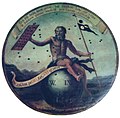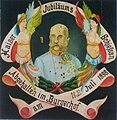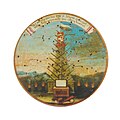Scheibbs shooting target museum

The Scheibbs shooting target museum, with around 250 historical exhibits, is the largest of its kind and houses shooting targets from Scheibbs from 1670 to 1941. It was founded in 1991 in Scheibbs , Lower Austria , and provides an overview of the history of Central European shooting, especially as a supplement to hunting or (par) military shooting. Mainly on display are painted panes from the Scheibbs rifle guild, which date from 1670 to the present day. The museum is operated by the Schützengilde Scheibbs together with the municipality of Scheibbs.
Tradition of the Schützengmein
Scheibbs has an important tradition as a shooting guild. In 1568, the city acquired the shooting range in front of the Wiener Tor, the place where the Capuchin Church is located today, from the Carthusians of Gamingen . The so-called Schützengmein has existed since 1563, its chairman is called Meister . A special feature is the figure of the fool (called target or flatbed master ), who is responsible for order and security at the shooting range. This association was properly organized and upheld the customs , but did not want to pursue any military purposes. While the Tyrolean riflemen, for example, were paramilitary associations, the rifle being in Scheibbs developed as a proper tradition from the wreath shooting , and this wreath eventually became a target .
Archery goes back much further in its origins. In its very early days it emerged from a religious-mystical cult, the so-called bird's shot, a religious ritual that was supposed to bring about happiness and health in the community. A living bird, later a wooden bird, which was attached to a high pole, was shot with a bow and arrow. Whoever shot down the last part had shot the bird and was the winner. With the advent of the fire rifle, wooden disks were aimed at, most of which still depict the bird.
Such rifle clubs were only welcome to the authorities at a time when it was hoped that they could be used for the defense of their city, although this was never possible in practice. The reason is that as early as the 16th century the weapons of soldiers, hunters and riflemen were so different that they could not be exchanged for one another. During the Turkish attacks in 1529 and 1532, however, the Scheibbs citizens proved their skills in using weapons, the town of Scheibbs was never captured. At that time it was an absolute duty of every citizen to train himself in local defense with a gun.
In the time of Napoleon, the rifle system came to a standstill and it became an association-like organization.
collection
The Scheibbs shooting targets have been around since the end of the 17th century, and the collection includes 243 targets. The panes were originally painted by the court painters of the Gaming Carthusian monks, hence the artistic decoration and often with inscriptions , also in Latin . They were all in tempera painting. Current political and local events were chosen as topics, but also domestic scenes, private celebrations and commemorative motifs. Around 100 discs show the coat of arms of the Gaming Charterhouse and a theme related to the monks.
literature
- Michaela Hermann (text), Gerhard Trumler (photos): Scheibbs. Eisenstadt - Proviantstadt - Holzstadt . 244 illustrations. Bookstore Rudolf and Fritz Radinger, Scheibbs 2006 (without ISBN).
- Johann Riegler, Irmgard Dober: Scheibbs . Ueberreuter, Vienna 2007, ISBN 978-3-8000-7303-0 .
Web links
Individual evidence
- ↑ a b c Welcome to the Schützenscheibenmuseum. Municipality of Scheibbs ( Memento from February 1, 2013 in the web archive archive.today ).
- ↑ a b SchützenScheibenScheibbs at the Lower Austrian Museum Management, accessed on April 15, 2016.
Coordinates: 48 ° 0 '18.9 " N , 15 ° 10' 2.6" E







